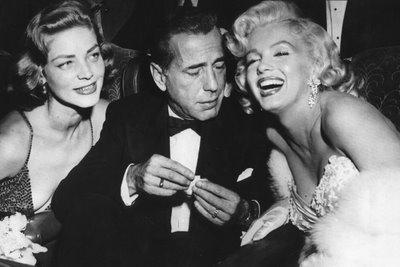Actor's tricks...

I'm seeing a lot of movies lately and there's plenty of bad acting along for the ride. If you start from the premise that everyone on screen wants an Oscar, it's pretty funny to watch these needy souls ham it up with enough honey-glaze to slather a mastodon. Watch, you'll notice.
I'll admit, it's got to be hard up there in front of the camera, having to pull a character out of thin air and make it believable in a medium that has little to do with our own universe. I've noticed there are a few tricks that actors use again and again. I should add that I've never acted and know nothing about the craft. These are just some layman's observations.
Most of the trouble starts when you have actors in service of a rigid plot. The gulf between actor and story becomes glaringly obvious. The Prestige is a great example of this. Director Christopher Nolan has so many twists and turns and details he needs to cram into this mystic pizza, the actors (and the audience) are worn out in the first half as he ticks items off his to do list. Better movies seem to allow (great) actors the freedom to play with a loose narrative structure - to let the story match the characters in an indistinguishable blur (i.e. Venus).
So, an actor's trick: You can just hear a crusty ascot-wearing acting coach telling Brad Pitt that he has "magnificent arms and hands" and that he should use them frequently to "lead the action." So everywhere you see this guy, he's out there holding up walls, pointing at this, pointing at that. Didn't his mother tell him about pointing? And don't get me started about Renee Zellweger's mouth pout.
Which reminds me, another frequently seen trick is the micro-muscle movement, aka the limited-engagement facial tick. Here, in close up, at a moment of great intensity, a stand off between two characters can be silently punctuated by the subtlest twitch of an eyelid. Or a scorned wife being lied to by her husband for the millionth time might just give us the tiniest lip quaver. These motions are intended to be worth a thousand tears, punches, words, etc. But once you're on to it, the micro-twitch is as distracting as a ding on a brand new Porsche.
Putting full frontal shots aside, that whole good side/bad side of the face business is real. Cary Grant insisted on being shot from his right (the side where his laser beam part is. Have you ever noticed how he spends most of his time on the left side of the screen?) Sometimes you get two actors in a scene whose chosen facial aspect don't jive. This is where you'll start to see some funky blocking (actors situated in bizarre configurations so that we are blessed with two good sides) or editing (excessive cuts from one face to another).
The bad mustache. If you're an actor who discovers himself in a bad film you need to have at least one scene (preferably the whole film) where you sport obviously fake facial hair. If you can see the wire mesh and the glue holding the thing in place, all the better. It is a message to the audience that says, "You know and I know this is a piece of shit, but I need the money and at the same time I'm going to punish you and my agent and the director and anyone else remotely involved in my being here!" Eddie Murphy in Dreamgirls wins the prize for this one.
OK, I could continue, but this is waay too strange a territory for me to be lavishing so much attention on... All of this narcissism and useless critiquing is making me see sick.
(Bogart lavishes attention on "the girls"...)

1 Comments:
Great post Pablo. Keep it up!
Post a Comment
<< Home